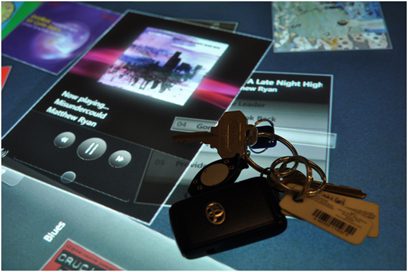
Microsoft’s 10,000th patent can, among other things, be used to associate objects such as keys placed on a Microsoft Surface computer with particular blocks of data, such as music files.
REDMOND, Wash. – Feb. 10, 2009 – The U.S. Patent and Trademark Office recently awarded Microsoft Corp. its 10,000th U.S. patent. The invention, U.S. Patent No. 7,479,950, applies to surface computing technology and outlines how users can place real objects — anything from cell phones to their own fingers — on the computer’s tablelike display and the computer will automatically identify the objects and track their position, orientation and motion. This allows the objects to be associated with data or media, like a specific collection of music or photos.
Curtis Wong, one of four co-inventors of the patent from Microsoft Research, explains that there are myriad uses for the patented technology in conjunction with Microsoft Surface computers or other touch-screen applications. For example, a group of photos from a particular vacation could be associated with a souvenir from the trip. Placing the souvenir on a Microsoft Surface computer might initiate a slide show. Rotating the souvenir accelerates or slows the playback speed. Placing it on another area of the screen would “spill” the photos onto the Surface display, allowing the user to edit, delete or add photos to that collection with simple gestures.
Or a user might choose to associate a collection of party music with a matchbox from a favorite music club. Placing the matchbox on Microsoft Surface would cause all the album covers within that party mix to jump out, so the user can rearrange the playlist. From there, she could place the matchbox on a play button to hear the music, and then rotate the matchbox to scroll through the other albums. She could also add music to that playlist by touching related albums and “flicking” them into the matchbox.
Wong notes that objects can be used to identify individual users on a shared machine and trigger their preferences. For example, the members of a family might use unique personal objects as identifiers. When the teenage son places his keys on a surface computer, the technology recognizes them and automatically brings up sports scores, his playlist and his homework assignment. Later, when mom puts her purse on the surface, the computer can automatically bring up several predetermined items, including her daughter’s soccer game schedule and maps with driving directions to the away games.
“Surface computing gives people instant access to digital information in a new way,” says Wong. “The goal of this patent is to make the interaction between the physical and virtual worlds a little more seamless.”
Wong joined Microsoft Research in 1997 and has authored more than 45 patent applications in a variety of arenas. Last year, he and his team launched the WorldWide Telescope, a rich Web application that brings together imagery from the best ground- and space-based observatories to allow kids of all ages to explore and understand the universe with astronomers as their guides.
Quality Versus Quantity
Microsoft currently ranks fourth among companies receiving the most U.S. patents, with just over 2,000 patents in 2008. The company spends about US$8 billion a year on R&D, more than any other company in the industry.

Bart Eppenauer, chief patent counsel, oversees Microsoft’s patent portfolio
“Most technology companies, Microsoft included, have been increasing their emphasis on IP in recent years, trying to derive greater business value from their intellectual assets,” says Bart Eppenauer, chief patent counsel, who oversees Microsoft’s patent portfolio. “One way to value a patent portfolio is to look at the quantity of patents it contains. Another way is to look at the influence the portfolio has on others.”
In December 2008, the Institute of Electrical and Electronics Engineers (IEEE) ranked Microsoft’s patent portfolio first in terms of its power and influence for the second year in a row, not just among software companies, but across all industries. One of the main indicators the IEEE looks at to determine “Patent Power” is how often a company’s patents are cited as prior art in other companies’ patent applications.
“Patents are the currency of innovation,” says Eppenauer. “They enable Microsoft to share our innovations with others through licensing, and that in turn enables others to share their innovations back with us.”
In December 2003, Microsoft made a public commitment to broaden its IP licensing efforts, shifting from a defensive posture to a proactive, collaborative one. Since then the company has signed more than 500 licensing agreements, with companies of all sizes and types, from fledgling startup ventures to longtime industry partners and competitors.
Collaboration Versus Competition
An interesting transition has taken place in the world of patents and intellectual property. For many years, patents were thought of as clubs to be used in court against one’s competitors. “What we’re seeing more often in the past several years is that patents and IP are now serving as bridges to collaboration through licensing and other technology collaboration,” says Eppenauer.
Patents as knowledge-sharing tools may seem counterintuitive at first. After all, patents do give their owners the right to exclude others from using a technology. But even in this case, denying use is very different from denying to others the knowledge of the new technology, which patents by law are required to disclose.
But Eppenauer says that’s no longer the case. “Let’s face it,” he says, “the days of the self-contained, go-it-alone company are over. This is especially true during the current economic downturn. Open innovation is more critical than ever in today’s business world.”




